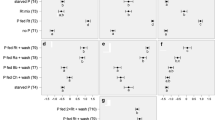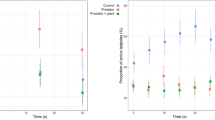Abstract
Many aquatic organisms detect and avoid damage-released cues from conspecifics, but the chemical basis of such responses, and the effects of prolonged exposure to such cues, remain poorly understood. Injured tadpoles of the cane toad (Rhinella marina) produce chemical cues that induce avoidance by conspecific tadpoles; and chronic exposure to those cues decreases rates of tadpole survival and growth, and reduces body size at metamorphosis. Such effects suggest that we might be able to use the cane toads’ alarm cue for biocontrol of invasive populations in Australia. In the present study, we examined behavioral and ecological effects of compounds that are present in cane toad tadpoles and thus, might trigger avoidance of crushed conspecifics. Four chemicals (L-Arg, L-Leu-L-Leu-OH, L-Leu-L-Ile-OH and suberic acid) induced behavioral avoidance in toad tadpoles at some (but not all) dosage levels, so we then exposed toad larvae to these chemicals over the entire period of larval development. Larval survival and size at metamorphosis were decreased by chronic exposure to crushed conspecifics (consistent with earlier studies), but not by exposure to any of the four chemicals. Indeed, L-Arg increased body size at metamorphosis. We conclude that the behavioral response to crushed conspecifics by cane toad tadpoles can be elicited by a variety of chemical cues, but that consistent exposure to these individual chemical cues does not affect tadpole viability or developmental trajectory. The optimal behavioral tactic of a tadpole may be to flee if it encounters even a single chemical cue likely to have come from an injured conspecific (indicative of predation risk), whereas the continuing presence of that single chemical (but no others) provides a less reliable signal of predation risk. Our data are consistent with results from studies on fish, that suggest a role for multiple chemicals in initiating alarm responses to damage-released cues.





Similar content being viewed by others
References
Alford RA (1999) Ecology: resource use, competition and predation. In: McDiarmid RW, Altig R (eds) Tadpoles: the biology of anuran larvae. University of Chicago Press, Chicago, pp 240–278
Austin CE, March RE, Stock NL, Murray DL (2018) The origin and ecological function of an ion inducing anti-predator behavior in Lithobates tadpoles. J Chem Ecol 44:178–188
Baker GC, Beebee TJC (1997) Microenvironmental effects on competition between Rana and Bufo larvae, and the abundance of Prototheca richardsi, in small fish-ponds. Herpetol J 7:149–154
Barbul A, Rettura G, Levenson SM, Seifter E (1983) Wound healing and thymotropic effects of arginine: a pituitary mechanism of action. Am J Clin Nutr 37:786–794
Bardsley L, Beebee TJC (2001) Non-behavioural interference competition between anuran larvae under semi-natural conditions. Oecologia 128:360–367
Beebee TJC (1995) Tadpole growth: is there an interference effect in nature? Herpetol J 5:204–205
Beeching SC, Caroff JT, Case SL, Duda SH, Henry BE, Pristov KE (2015) Avoidance behavior in two sympatric planaria species: effects of conspecific and heterospecific chemical alarm cues. Mar Freshw Behav Physiol 48:445–453
Berven KA (1981) Mate choice in the wood frog, Rana sylvatica. Evolution 35:707–722
Berven KA, Gill DE (1983) Interpreting geographic variation in life-history traits. Am Zool 23:85–97
Brown GP, Phillips BL, Webb JK, Shine R (2006) Toad on the road: use of roads as dispersal corridors by cane toads (Bufo marinus) at an invasion front in tropical Australia. Biol Conserv 133:88–94
Cabrera-Guzmán E, Crossland MR, Brown GP, Shine R (2013) Larger body size at metamorphosis enhances survival, growth and performance of young cane toads (Rhinella marina). PLoS One 8:e70121
Child T, Phillips BL, Shine R (2009) Does desiccation risk drive the distribution of juvenile cane toads (Bufo marinus) in tropical Australia? J Trop Ecol 25:193–200
Clarke RD (1974) Postmetamorphic growth rates in a natural population of the Fowler’s toad, Bufo woodhousei fowlerii. Can J Zool 52:1489–1498
Crossland MR, Shine R (2012) Embryonic exposure to conspecific chemicals suppresses cane toad growth and survival. Biol Lett 8:226–229
Crossland MR, Alford RA, Shine R (2009) Impact of the invasive cane toad (Bufo marinus) on an Australian frog (Opisthodon ornatus) depends on minor variation in reproductive timing. Oecologia 158:625–632
Crossland MR, Haramura T, Salim AA, Capon RJ, Shine R (2012) Exploiting intraspecific competitive mechanisms to control invasive cane toads (Rhinella marina). Proc R Soc B 279:3436–3442
Crossland MR, Hearnden MN, Pizzatto L, Alford RA, Shine R (2011) Why be a cannibal? The benefits to cane toad, Rhinella marina [= Bufo marinus], tadpoles of consuming conspecific eggs. Anim Behav 82:775–782
Dalesman S, Rundle SD, Cotton PA (2007) Predator regime influences innate anti-predator behavior in the freshwater gastropod Lymnaea stagnalis. Freshw Biol 52:2134–2140
Daly JM, Reynolds J, Thom A, Kinsley L, Dietrick-Gallagher M, Shou J, Ruggieri B (1988) Immune and metabolic effects of arginine in the surgical patient. Ann Surg 208:512–523
Døving KB, Hamdani EH, Hoglund E, Kasumyan AO, Tuvikene A (2005) Review of the chemical and physiological basis of alarm reactions in cyprinids. In: Reutter K, Kapoor BG (eds) Fish chemosenses. Science Publishers, Enfield, pp 133–164
Faulkner AE, Holstrom IE, Molitor SA, Hanson ME, Shegrud WR, Gillen JC, Willard SJ, Wisenden BD (2017) Field verification of chondroitin sulfate as a putative component of chemical alarm cue in wild populations of fathead minnows (Pimephales promelas). Chemoecology 27:233–238
Ferland-Raymond B, Murray DL (2008) Predator diet and prey adaptive responses: can tadpoles distinguish between predators feeding on congeneric vs. conspecific prey? Can J Zool 86:1329–1336
Ferland-Raymond B, March RE, Metcalfe CD, Murray DL (2010) Prey detection of aquatic predators: assessing the identity of chemical cues eliciting prey behavioural plasticity. Biochem Syst Ecol 38:169–177
Ferrari MCO, Wisenden BD, Chivers DP (2010) Chemical ecology of predator-prey interactions in aquatic ecosystems: a review and prospectus. Can J Zool 88:698–724
Fraker ME, Hu F, Cuddapah V, McCollum SA, Relyea RA, Hempel J, Denver RJ (2009) Characterization of an alarm pheromone secreted by amphibian tadpoles that induces behavioral inhibition and suppression of the neuroendocrine stress axis. Horm Behav 55:520–529
Gosner KL (1960) A simplified table for staging anuran embryos and larvae with notes on identification. Herpetologica 16:183–190
Griffiths CL, Richardson CA (2006) Chemically induced predator behavior in the burrowing bivalve Macoma balthica. J Exp Mar Biol Ecol 331:91–98
Hagman M, Shine R (2008a) Understanding the toad code: behavioural responses of cane toad (Chaunus marinus) larvae and metamorphs to chemical cues. Austral Ecol 33:37–44
Hagman M, Shine R (2008b) Australian tadpoles do not avoid chemical cues from invasive cane toads (Bufo marinus). Wildl Res 35:59–64
Hagman M, Shine R (2008c) Tadpoles of invasive cane toads (Bufo marinus) do not respond behaviourally to chemical cues from tadpoles of four species of Australian frogs. Aust J Zool 56:211–213
Hagman M, Shine R (2009a) Species-specific communication systems in an introduced toad compared with native frogs in Australia. Aquat Conserv 19:724–728
Hagman M, Shine R (2009b) Larval alarm pheromones as a potential control for invasive cane toads (Bufo marinus) in tropical Australia. Chemoecology 19:211–217
Hagman M, Hayes RA, Capon RJ, Shine R (2009) Alarm cues experienced by cane toad tadpoles affect post-metamorphic morphology and chemical defences. Funct Ecol 12:126–132
Hews DK (1988) Alarm responses in larval western toads, Bufo boreas: release of larval chemicals by a natural predator and its effect on predator capture efficiency. Anim Behav 36:125–133
Howard RD (1978a) The evolution of mating strategies in bullfrogs, Rana catesbeiana. Evolution 32:850–871
Howard RD (1978b) The influence of male-defended oviposition sites on early embryo mortality in bullfrogs. Ecology 59:789–798
Lever C (2001) The cane toad. The history and ecology of a successful colonist. Westbury Academic and Scientific Publishing, Otley
Lucon-Xiccato T, Chivers DP, Mitchell MD, Ferrari MC (2016) Making the dead talk: alarm cue-mediated antipredator behaviour and learning are enhanced when injured conspecifics experience high predation risk. Biol Lett 12:20160560
Mathuru AS, Kibat C, Cheong WF, Shui G, Wenk MR, Friedrich RW, Jesuthasan S (2012) Chondroitin fragments are odorants that trigger fear behavior in fish. Curr Biol 22:538–544
McDiarmid RW, Altig R (1999) Tadpoles: the biology of anuran larvae. University of Chicago Press, Chicago
Mokany A, Shine R (2003) Biological warfare in the garden pond: tadpoles suppress the growth of mosquito larvae. Ecol Entomol 28:102–108
Oplinger CS (1966) Sex ratio, reproductive cycles, and time of ovulation in Hyla crucifer crucifer Wied. Herpetologica 22:276–283
Petranka JW (1995) Interference competition in tadpoles: are multiple agents involved? Herpetol J 5:206–207
Phillips BL, Brown GP, Webb J, Shine R (2006) Invasion and the evolution of speed in toads. Nature 439:803
Pizzatto L, Stockwell M, Clulow S, Clulow J, Mahony M (2014) Chemical communication in green and golden bell frogs: do tadpoles respond to chemical cues from dead conspecifics? Chemoecology 24:171–177
Quadros VA, Costa FV, Canzian J, Nogueira CW, Rosemberg DB (2018) Modulatory role of conspecific alarm substance on aggression and brain monoamine oxidase activity in two zebrafish populations. Progr Neuro-Psychopharmacol Biol Psych 86:322–330
R Core Team (2016) A language and environment for statistical computing. R Foundation for Statistical Computing, Vienna, Austria. https://www.R-project.org/
Sehr EK, Gall BG (2016) Responses of an aquatic isopod and amphipod to chemical alarm cues from damaged conspecifics. J Freshw Ecol 31:231–237
Shine R (2010) The ecological impact of invasive cane toads (Bufo marinus) in Australia. Q Rev Biol 85:253–291
Smith DC (1987) Adult recruitment in chorus frogs: effects of size and date of metamorphosis. Ecology 68:344–350
Sorensen PW, Johnson NS (2016) Theory and application of semiochemicals in nuisance fish control. J Chem Ecol 42:698–715
Tyler MJ (1994) Australian frogs: a natural history. Reed New Holland, Sydney
Wagner CM, Kierczynski KE, Hume JB, Luhring TM (2016) Exposure to a putative alarm cue reduces downstream drift in larval sea lamprey Petromyzon marinus in the laboratory. J Fish Biol 89:1897–1904
Wassersug RJ (1997) Assessing and controlling amphibian populations from the larval perspective. In: Green D (ed) Amphibians in decline: Canadian studies of a global problem. Society for the Study of Amphibians and Reptiles, Saint Louis, pp 271–281
Wilbur HM, Rubenstein DI, Fairchild L (1978) Sexual selection in toads: the roles of female choice and male body size. Evolution 32:264–270
Zhou Y, Loeza-Cabrera M, Liu Z, Aleman-Meza B, Nguyen JK, Jung SK, Choi Y, Shou Q, Butcher RA, Zhong W (2017) Potential nematode alarm pheromone induces acute avoidance in Caenorhabditis elegans. Genetics 206:1469–1478
Acknowledgements
We thank the Australian Research Council for supporting this research, and Michelle Franklin for assistance with behavioral assays.
Author information
Authors and Affiliations
Corresponding author
Electronic supplementary material
ESM 1
(PDF 2755 kb)
Rights and permissions
About this article
Cite this article
Crossland, M.R., Salim, A.A., Capon, R.J. et al. The Effects of Conspecific Alarm Cues on Larval Cane Toads (Rhinella marina). J Chem Ecol 45, 838–848 (2019). https://doi.org/10.1007/s10886-019-01111-2
Received:
Revised:
Accepted:
Published:
Issue Date:
DOI: https://doi.org/10.1007/s10886-019-01111-2




